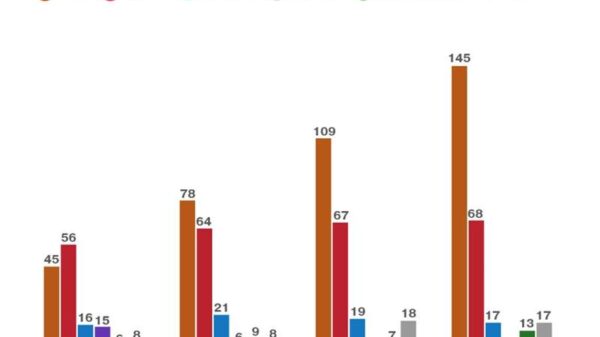An intriguing study on mice has raised questions about how hormones affect the brain and drive the body to move.
A new study on mice that examined DNA, hormones, and brain cells has shown that estrogen may alter brain activity in ways that can affect our physical activity. The study used advanced technology to reprogram and pinpoint specific genes and neurons in mice to find that estrogen surges triggered processes in the brains of the animals that led to increased activity, even in males.
The study was done on mice and was recently published in Nature. Although humans share many of the same hormones, genes, and neurons as mice, it is not possible to know if our brains and physiological systems function in the same way. These findings could open up new avenues for inquiry into the reasons women become inactive when estrogen disappears. These results show how the brain and other biological processes play an important role in whether or not the body moves.
Mating and moving
Since the 1924 landmark study involving rats in which scientists discovered that female mammals are most physically active right before they ovulate and when they are most sexually responsive, this has been known for close to 100 years. This is evolutionary logic, as female mammals need to hunt for mates. Researchers began to suspect that estrogen may be a driver of this behavior over the years. Later studies showed that female lab animal’s daily skitterings would increase and decrease with their estrogen levels.
How could estrogen, which is responsible for controlling ovulation and other aspects, affect physical activity? Holly Ingraham, the Herzstein Endowed Prof of Physiology at University of California San Francisco, was recently drawn to this physiological puzzle. Holly has a longstanding interest in women’s physiology, metabolism, and has a longstanding research interest. Her collaborators wondered if estrogen could somehow influence genetic activity in the brain. This would activate brain cells in ways that could trigger motion.
Scientists first collected a group of healthy female mice, and then chemically blocked some estrogen uptake. They also tracked how many animals moved. The animals that were not given estrogen became more sedentary almost immediately than the females. This is a confirmation of estrogen’s effect on physical activity.
Locating the movement cells
The researchers next examined the activity of several genes in the brains of the animals. They found that one gene, melanocortin-4, pumped out more proteins when they were given estrogen, but was almost silent when it was not. The gene melanocortin-4 (or Mc4r) was previously linked to regulation of body weight and food intake. Scientists now believe it could also be the link between estrogen and the desire to be physically active. This idea was supported by Jessica Tollkuhn (an assistant professor at Cold Spring Harbor Laboratory School of Biological Sciences, Cold Spring Harbor, N.Y.).
These techniques revealed estrogen binding to Mc4r genes within certain neurons in real-time, particularly in the part of the mouse brain that is involved in energy expenditure. These brain cells also had connections to other neurons in the brain that regulate the speed of animals’ movements. This experiment revealed that estrogen triggers a specific gene in the brain that allows animals to move faster.
Scientists had yet to see these genes and neurons in action so they used a complex technique called chemogenetics as a final part of their study to galvanize the relevant neuronal cells in female mice. These mice had been genetically bred not to produce estrogen. These mice, once slow and sluggish, now explore, stand, play, and run far more than ever before.
The scientists also used CRISPR, a form gene-editing technology, to increase Mc4r gene activity in the brains of female mice. This resulted in mice becoming almost twice as active than before. This physical surge lasted for several weeks. CRISPR dialed up Mc4r gene activity in male mice, but not as much as the females. However, this made male mice move faster.
Dr. Ingraham stated that these results demonstrate the “complexity” of physical activity behavior. He said that the ability to spontaneously move for any animal is likely to be a result of a complex interplay between genetics and neurology as well as conscious deliberation.
This study raises intriguing questions about whether the timing of exercise might have the most beneficial effect for women if it is adjusted to the changing hormonal environment. Dr. Tamas Horvath, who is a Yale School of Medicine professor of neuroscience, obstetrics and reproductive sciences and chair of the school’s department of comparative medical, stated that this possibility could be a result of the study.
Dr. Horvath was not involved in this research. He said, “Of course all these observations in mice must be confirmed to work in us, humans.” However, this mechanism was found in an old part of the brain, which suggests it can be applied to all mammals, including humans.
“Knowledge is power”
Dr. Ingraham also agreed. Dr. Ingraham agreed. For example, estrogen levels may be higher in older women. However, estrogen replacement therapy is still a complex topic due to increased cancer risks and other health concerns.
However, the study suggests that it may be possible to bypass estrogen in the future and recreate its effects using new therapies that directly target the Mc4r gene and the relevant neurons in people’s brains. This would mimic estrogen’s effects without actually using the hormone. Dr. Ingraham stated that such medical breakthroughs are still years away.
However, the study already delves into the “interrelationship between hormonal activity in females,” and has “significant implications for human research studying menstrual cycles and hormonal contraceptives as well as menopause,” explained Paul Ansdel. He is a lecturer in exercise and physiology at Northumbria University, England. “So the challenge now is to find the best ways to remain active during the major hormonal transition that’s menopause.”
Dr. Ingraham concluded that “Knowledge makes the difference.” Ingraham noted that we are all living longer and better understand why and how we move. This can make our years more healthy. If biology is pointing us towards the couch, as it does for women, then we can use fitness trackers and training diaries to compare our activities year to year. You can also honestly evaluate your current level of activity, regardless of age or gender. Although the brain is complex and we have many motivations for exercising, Dr. Ingraham stated that we always have the option to “decide to be active”. To do this, you can get up and move.































